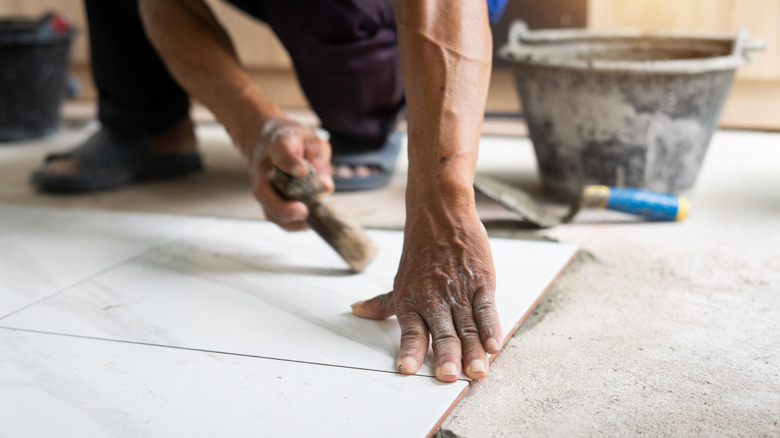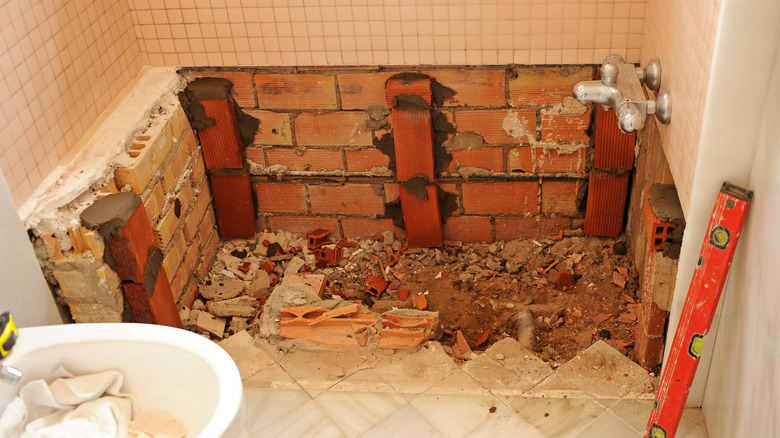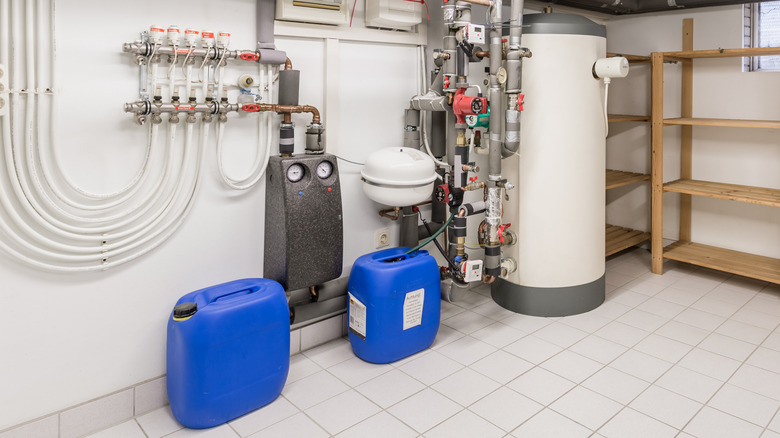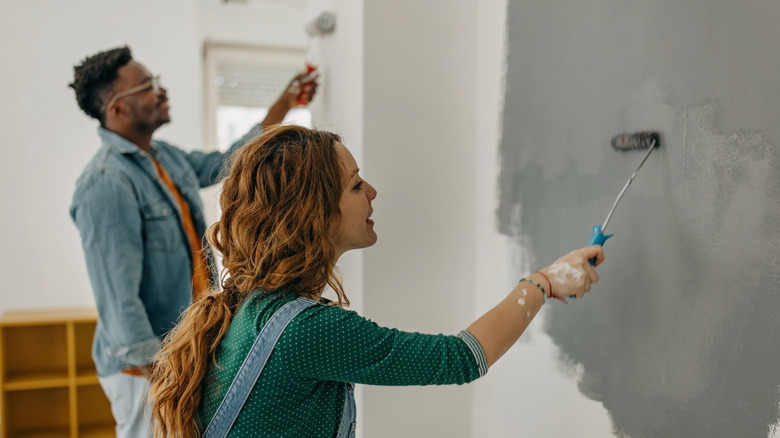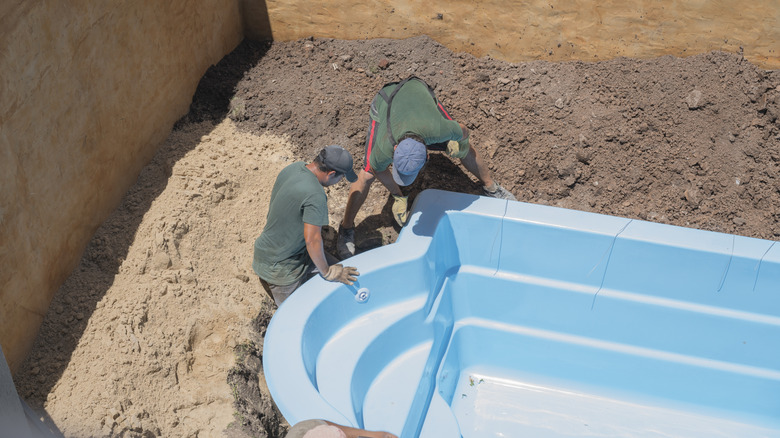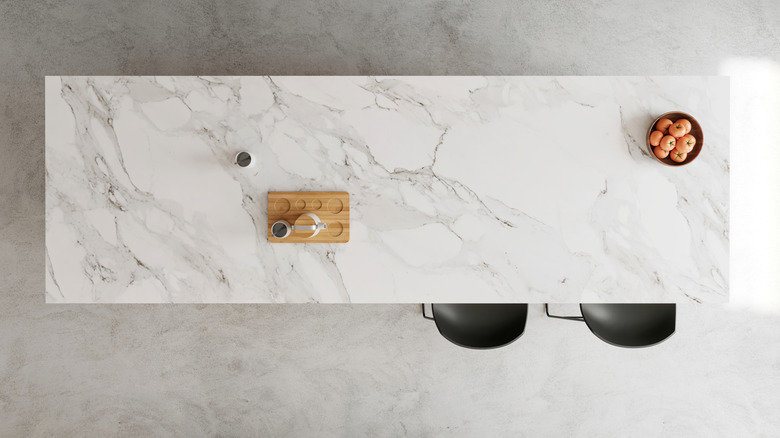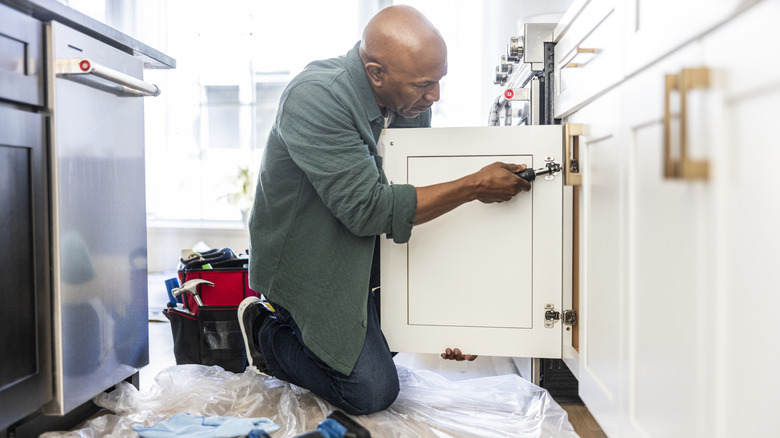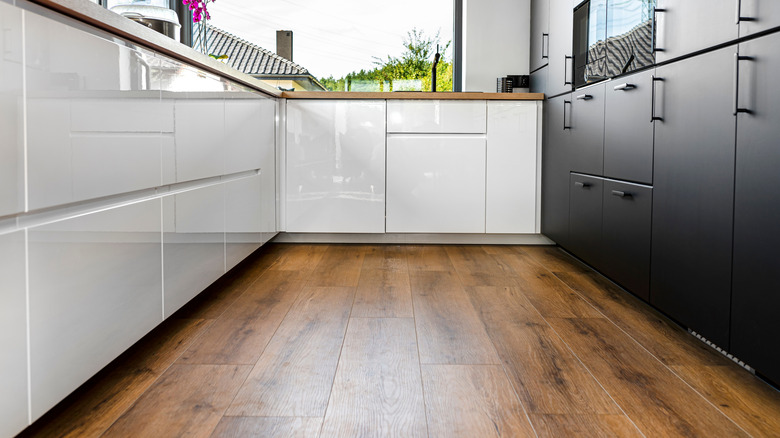Home Upgrades That Are A Waste Of Money, According To HGTV's Mike Holmes
Most folks upgrade their homes for two reasons: To make them more liveable for everyday life and to boost the home's resale value. However, according to Canadian contractor and HGTV star Mike Holmes, there are plenty of so-called upgrades that will turn out to be a complete waste of cash, no matter your reason for including them. Some of his suggestions are material- or feature-specific — as in, never put this in your house, because you're not going to see any returns on the investment. However, others depend on your home's current state and how you plan to use the upgrade. This means that what's a waste for some might not be for others.
However, there is such a thing as getting too swept away with changes. "Watch out for over-improving," Holmes warns on his blog, Make It Right. "All those new features and over-the-top finishes can add up fast. This is especially true when that money should be used on more important things, like fixing the leaky roof or basement or replacing the old furnace." So once your house has the bare bones intact and is fully functioning, what does Holmes still think you should skip? These are his top recommendations and his reasons behind each choice.
DIY tiling jobs don't tend to work out
Laying tile in your home is something that Holmes always believes should be left to the professionals. He thinks DIY tiling jobs are a waste of money because, in his experience, working with a contractor will save you both time and money on supplies and labor in the long run. "Installing tile requires experience and skill, not to mention the materials, supplies, and tools it takes to complete the job," he shared on Make It Right. "Professional tile setters have spent years perfecting their art." He explained that DIY-ing this upgrade requires a skill set that most beginners simply don't have. Plus, they will have to factor in higher costs for fixing mistakes, because it's very likely that some of the self-laid tiles are going to crack sooner rather than later, especially if laid on the floor.
In Canada, where Holmes is from, there are certain licenses required to be a professional tile-layer. However, the requirements for having one of these vary from state to state in the U.S. For example, in Texas, licensing requirements are more scant, while in California, workers must have more documents to prove their experience. That said, no matter which state your project is in, look for a contractor with a robust portfolio and perhaps an education certification, such as one from the Ceramic Tile Education Foundation.
Removing bathtubs for luxury showers might lower home value
Taking the tub out of your bathroom is a waste of money in certain circumstances, according to Holmes. "The general rule is if your home only has one bathroom, then you should keep your tub," he wrote on Make It Right. This is for both everyday practical and resale purposes, as having at least one bathtub on site is "great for relaxing or if you have kids or pets at home." However, if you have two full bathrooms and they both have bathtubs, then Holmes thinks it's fine to take one out.
His reasoning is backed up by buying trends, as a 2021 report by the National Association of Home Builders states that 72% of buyers would prefer there be both a tub and a shower in the master suite. Without the tub present, this portion of the buying pool might be put off by your property. However, it is difficult to assign an actual monetary loss to remove the tub, as properties do tend to grow in value over time regardless. So, if you wait long enough, or if your current home is your forever home, removing the only tub might not be as big of a waste.
DIYing a basement bathroom installation can cost you more in the long run
Renovating your unfinished basement to make it more welcoming and functional is a home upgrade that is often worth it, as it instantly adds heaps of more livable square footage to your home without expanding its footprint. However, Holmes warns against adding a bathroom to the level if there already isn't one — at least if you are trying to do it yourself. It can easily turn into a money pit due to a lack of experience. "Basement bathrooms present unique challenges. The convenience of an extra bathroom comes with a lot of appeal for homeowners. But do it right, with proper planning and permits, so I don't need to come in and fix it," he warned on Make It Right. "Installing a basement bathroom is not a simple DIY job — that's why there are professionals with experience and training to do it for you."
His reasoning is solid in that adding a new bathroom includes installing intricate parts like exhaust fans, heated flooring, plumbing, and electrical outlets. Unlike something more simple like painting or putting in carpet, completing these tasks incorrectly, even just a little bit, has the potential to snowball into a very expensive and even unsafe situation. Think anything from flooding the basement with mislaid plumbing, to starting an electrical fire due to shoddy work. For Holmes, fixing these problems later just isn't worth the cost. It's better value to do it right the first time by hiring a professional — much like how he feels about DIYing tile.
New features that aren't smart and energy efficient will cost you
If you are remodeling your home and swapping out any appliances, Holmes thinks it is a total waste of money to purchase options that aren't specifically eco-friendly. He insists that any extra upfront costs will be more than covered by the potential savings from tax credits and lower bills. "Incorporating energy-efficient features into your project, such as improved insulation, energy-efficient appliances like tankless water heaters, EV chargers, and eco-friendly building practices, will reduce your carbon footprint and lower energy costs," he shared on Make it Right when discussing the biggest ways to have a successful home renovation.
To discover the best eco-friendly appliances, a great place to begin your search is the Energy Star website. You can type in your zip code and find information about tax credits, rebates, and discounts in your area on all sorts of features. Aside from that, Holmes also recommends making smaller switches around the house, like using LED bulbs and a remotely programmable thermostat. In his opinion, home upgrades without these energy-efficient money-saving features aren't really upgrades at all.
Don't repaint or swap flooring if you have other glaring issues
One of the biggest wastes of money that Holmes sees when he's cleaning up shoddy work is people who decide to do smaller cosmetic home upgrades, like painting, when the very foundations of the property are what really need desperate attention. His best advice to avoid this is to take stock of your home's health from head to toe before upgrading anything, lest you waste money. "To me, it just makes sense to protect your home from the outside-in," he wrote on Make It Right. "That way you can ensure all the updates you make inside are protected." He drives this point home by emphasizing the financial blow (and frustration) that would come from completely remodeling your basement, only to have to rip it all up because you then discover there is a crack in the foundation.
The best way to find these problems is to complete a home inspection. Often done before buying a property, it can be useful to get a gauge on the health of your home's roof, electrical systems, and foundation before sinking tens of thousands of dollars on aesthetic fixes. You can typically hire a home inspector to complete a walk through of your home, or partner with your general contractor if you don't want to hire someone who doesn't come with a referral. Home inspectors look for things like foundation problems, roof issues, and malfunctioning HVAC systems.
Pools may or may not be worth it
Swimming pools are a controversial home upgrade, even for Holmes. Whether or not they are truly a complete waste of money really depends on how often you plan to use the amenity, and how long you plan to stay in your house. "What it comes down to is the 50/50 ratio. Half the buyers out there want a pool, the other half don't want a pool — they don't want the extra cost," he said in Episode 3 of the Holmes on Homes Podcast. "They're afraid that somebody could drown in it. They don't want to follow the bylaws, etc., etc."
Unfortunately, Holmes doesn't reveal a definite way of knowing whether installing a pool is worth it or not. "All depends on the buyer ... but it costs money to upkeep, so if you use it for years, you might not come out ahead," he continued. "However, it can make you happy — real catch-22." With that said, the only real determining factor here isn't a financial one, but rather one of joy and lifestyle. If you think having a pool would make your everyday life better, regardless of the financial investment, then it likely is something that just might be worth it for your household.
Marble countertops are easily damaged and take too much work to upkeep
The best countertop material for kitchens is another highly contentious topic in the design community, but for Holmes, there is one option that is just never worth the cash: marble. He understands the appeal since, after all, marble is gorgeous. However, it's too hard to take care of for the average homeowner and can be ruined easily. "Marble countertops offer elegance and sophistication to any kitchen or bathroom. Marble's distinctive veining and natural variations make each piece unique," he wrote on Make It Right. "However, marble is softer than granite and quartz, making it more susceptible to scratching and staining. It also requires frequent sealing."
Instead of marble, Holmes recommends quartz if you plan on upgrading your countertops. This material is just as stylish as marble, but it requires less overall care. Because of this, it's a great option for busy families. Plus, "the best part is that quartz countertops resemble the look of actual stone, such as marble and granite, and come in a variety of colors and patterns," Holmes wrote. He even likes the material so much that he has it in his own kitchen, too.
Any major upgrade that doesn't consider the future is a waste for forever homes
If you plan to stay in your current home long term, Holmes considers any home renovation that doesn't think about long-term accessibility a waste of money. This is because you're going to spend tens of thousands on a renovation now, but need to re-spend down the line to make your home more livable as you age. To him, doubling up like this is silly. "Create a home that is barrier-free and universally accessible, allowing for easy movement throughout the house," he shared on Make It Right. "Allowing for flexible use of space, such as a den that can double as a bedroom when needed."
By making a few small tweaks to your renovation plans, you can save yourself cash in the long term. For example, "Doors need to be wider to accommodate wheelchairs and walkers," Holmes advised on another Make It Right post. He notes that doorways should be at minimum 32-inches wide, but aim for 36-inches, if possible. In the bathroom, ensuring your shower has a built-in bench for resting and doesn't have a lip you need to step over to enter are also essential. Leaving room for installing grab bars later on is also a good idea. For flooring, Holmes urges homeowners to consider options like LVP or thinner carpet, which tend to be scratch-resistant or easier to walk on overall.
New cabinets will likely fail if installed alone
Don't spend all that cash just to have it come crashing down — upgrading your cabinets is a waste of money if you plan to do it yourself. "When redoing your cabinets, I wouldn't handle the installation on my own," Holmes warned on Make It Right. "Think about it — cabinets are heavy objects, plus think about what goes into them: plates, glasses, food items — all added weight." One mistake in anchoring them to the wall will not only cost you the cabinet, but also everything inside of it, too.
Instead, be sure to hire a licensed and insured contractor to complete the job correctly. It's a good idea to ask the contractor a few questions before your kitchen remodel to get an idea of their skills and working style. For cabinets specifically, you can ask for some references from past clients to make sure people are happy with their updates years later.
Vinyl flooring doesn't belong in the kitchen
When swapping out the flooring in your kitchen, Holmes thinks upgrading with vinyl is a waste of money. "I don't install vinyl flooring in kitchens," he wrote on Make It Right. His reasoning is simple: most options just aren't durable enough. "Vinyl flooring is also not damaged [sic] resistant," he continued. "Drop a couple of sharp objects on the floor and you will likely see dents. They CAN be durable, depending on the grade." If you already have vinyl in your home, you're likely aware that some brands of the material do great holding up to moisture and scratches; however, it is so soft that it does tend to dent easily. This can be an issue in a high-traffic area like a kitchen with all the stools and chairs in constant motion.
As an alternative, Holmes recommends ceramic or porcelain tiles because they are durable and easy to keep clean. However, if you don't like the look of tile, or have an open floor plan and want to keep the same material throughout the level, laminate flooring and engineered hardwood also don't tend to dent and can be a great alternative.

